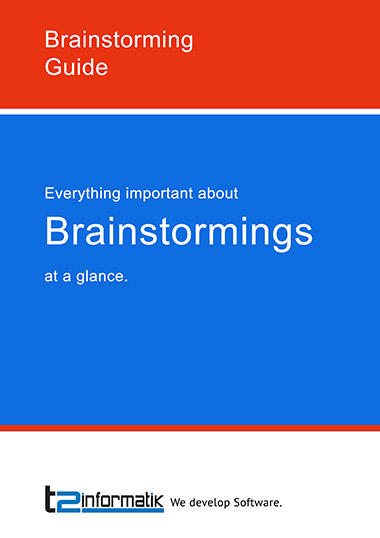What is Brainstorming?
Table of Contents: Definition – Procedure – Rules – Tips – Advantages and Disadvantages – Questions from practice – Download – Notes
Smartpedia: Brainstorming is a creativity technique in which a group of people work together to try to solve a task by collecting and developing ideas.
Brainstorming – the joint development of ideas in a team
The inventor of brainstorming Alex Faickney Osborn paraphrased his creativity technique as “Using the brain to storm a problem”. It is a format for groups to try to solve a task or problem by brainstorming together and then evaluating ideas.
Osborn based his development of brainstorming in 1939 on the Indian Prai Barshana technique, which has been around for about 400 years. Later, brainstorming was further developed by Charles Hutchison Clark as a method for finding ideas in a team. Today, brainstorming is considered a classic of creativity techniques, used in product and service development, in all conceivable organisational areas and organisations, or when solving problems.
Brainstorming procedure
Brainstorming follows a clear process of
- preparation,
- execution with idea generation and idea evaluation as well as
- follow-up.
In the course of brainstorming preparation, the team is put together on the basis of the problem, e.g. employees of a specialist area, experts of a subject area or external colleagues.
At the beginning of the execution, the brainstorming rules, the specific procedure and also the timebox (e.g. 30 or 45 minutes) should be given. In addition, it is advisable to name a minute-taker – in practice often identical to the moderator.
The moderator presents the problem. The problem should be visibly presented on a blackboard, a flipchart or a whiteboard at all times, so that the participants can more easily keep the required focus during the brainstorming session.
Now the participants can spontaneously give their ideas for solving the problem or finding a solution. Ideally, the participants inspire each other so that other ideas can be derived from individual ideas. All ideas have to be documented immediately. It is important to make sure that the information is not “translated” or “shortened” by the minute-taker / moderator. They should be documented as originally formulated by the participants and not “alienated”.
The idea generation is followed by the joint idea evaluation. For this, the ideas are grouped, analysed, filtered and evaluated. The aim of brainstorming is to create a list of the best ideas or proposed solutions in order to ideally realise the most promising one(s). The idea evaluation should also be provided with a timebox (e.g. 30 or 60 minutes).
At the end it is necessary to describe the further procedure: who does what until when, how do possible next steps look like, when do the participants possibly meet for a second round etc.?
In the course of the follow-up, the results are prepared and made available to the participants. It is also recommended to communicate new information, findings and developments on a regular basis.
Brainstorming rules
For brainstorming to work, there are some simple sonic rules to follow:
- The criticism of ideas and thoughts is forbidden to every participant (and thus also to the moderator or the minute-taker). General criticism of individual idea providers is also not permitted; the aim is an appreciative, open and fair communication to solve a problem or task.
- Any idea – as unlikely as it may sound – is a good idea.
- Ideas expressed may be further developed by all participants. There is therefore no copyright on ideas.
- Clear time limits as a timebox (e.g. 45 minutes for idea generation and 30 minutes for idea evaluation) and the goals of individual sessions must be communicated.
- Every participant can, but does not have to, engage in the session.
To ensure that brainstorming is effective, these rules should be followed. Appreciative and open communication is the key to success. By sharing and developing ideas, innovative solutions can be found.
Tips for conducting brainstorming sessions
There are a number of tips that have proven useful in practice:
- The participants should be clear about the process, the rules, the question and the objective as well as the timebox.
- Sometimes the questions are too extensive. In this case, it is advisable – also in the course of a session – to extract sub-questions and address them individually. If neither all sub-questions nor the general initial question can be answered within a session, a new date for a new exchange should be arranged.
- In order to keep to the timebox, there should be a timekeeper who also ensures that the agreed time is kept to even if there is a lively exchange among the participants.
- The climate during the collection and subsequent evaluation of ideas is important for the quantity and quality of the contributions. Of course, the moderator can try to have a facilitating effect, but it is the responsibility of all participants to adhere to the rules and, if necessary, to remind others in a friendly manner to follow them.
- Interdisciplinary brainstorming increases the understanding between roles, staff and areas on the one hand and offers different perspectives on the issue on the other.
- Visualising the contributions on a whiteboard or pinboard facilitates the exchange and promotes the refinement of ideas.
- The processing of the results and the derivation of measures round off the exchange. Here, too, the moderator and/or the timekeeper is asked to set aside enough time for this part of the meeting.
- In some situations it can be useful to make minor adjustments to the procedure. For example, in “Round Robin” the person who expresses an idea first then decides whether the person sitting to his or her left or right should express the next idea; this ensures that all participants have their say. And in “Silent Reflection”, participants are given the opportunity to jot down ideas in silence and for themselves before they are communicated verbally.
And last but not least: brainstorming may be fun, but it is not a joke. It is often about solving problems, enhancing products or services. The ideas are a means to an end. It is therefore always advisable to make sure that ideas are also implemented and that the implementation is discussed in the group of participants at a later point in time and, if necessary, also evaluated. Corresponding findings can be recorded in lessons learned, for example.
Brainstorming advantages and disadvantages
Brainstorming offers a number of advantages:
- The rules are easy to understand.
- The process is easy to implement with practice, an experienced moderator, a common goal and mutual consideration.
- The effort required for preparation, implementation and follow-up is kept within limits.
- The associative and non-judgmental collection of ideas is a great advantage of brainstorming.
- The joint promotion of divergent, diverse ideas is often a lot of fun.
However, there are also a number of challenges or disadvantages:
- Introverted employees often find it difficult to express thoughts and ideas in “public”.
- “Frequent speakers” or “loudspeakers” quickly negate the common purpose of brainstorming.
- Supervisors often communicate non-verbally what they think of the ideas and statements of individual participants. They may subsequently hold back and important perspectives are left out.
- Participants also often start judging opinions and thus consciously or unconsciously destroy the format and an exchange at eye level.
Adhering to the rules sounds relatively simple in theory, but in practice it is not always easy to implement. This is where the moderator is often particularly challenged. Without a good moderator, it is difficult to organise a successful brainstorming session. If he or she does not intervene in a moderating role, extroverted employees and/or supervisors will usually get their way and many ideas of more introverted employees will remain unspoken. The goal of brainstorming is missed. As an alternative, many organisations use different variants or alternatives.
Questions from practice
Here you will find some questions and answers in the context of brainstorming sessions:
What variants of alternatives to classic brainstorming exist?
Here is a list of some variants and alternatives that can be used to employ other forms of exchange, selected questioning techniques or defined structures:
- Brainwriting is a non-verbal creativity technique for brainstorming in which participants write down their ideas. The best-known variant is probably the 6-3-5 method.
- Braindumping describes the dumping of thoughts and ideas with the help of morning pages and task lists. So-called brain-netting and Idea Napkin work in a similar way.
- Reverse brainstorming is a format in which questions to be answered are formulated negatively and consolidated answers are turned into positive ones. Similar approaches can also be found in the headstand technique or the premortem.
- Round-robin brainstorming is a format in which all participants express themselves on a topic in a defined order (possibly in several rounds).
- 1-2-4-All is a format in which the number of participants per round is gradually increased. It is part of the so-called Liberating Structures.
- SCAMPER is a creativity method that uses a series of keywords and questions to facilitate the search for ideas. It is related to the Osborn checklist.
- Starbursting is a creativity method that uses questions to illuminate facets of a topic before seeking answers to the questions. Similar approaches can also be found in the 5-Why method or the 5W1H method.
- A pre-mortem is a forward-looking review that identifies causes that will contribute to the failure of projects.
- The headstand technique is a brainstorming format in which questions are turned into negatives and consolidated answers are turned into positives.
This list can certainly be extended with further variants and alternatives.
How useful is it to try out different variants or alternatives?
- Each format brings its own strengths and dynamics that can encourage different types of idea generation and group interaction.
- Not every team works effectively in the same way. Different variations or alternatives may suit different group characteristics differently.
- Different variations and alternatives may appeal to different participants and encourage them to contribute. Some people may feel more comfortable in open, free-flowing discussions, while others may work better in structured, rule-based formats.
- Utilising different approaches can help to break possible routines and motivate participants. This is particularly important to avoid creative blockages and maintain engagement over time.
Overall, experimenting with different variations and alternatives can be a valuable tactic to maximise the effectiveness of brainstorming sessions, improve team dynamics and find innovative solutions to a variety of challenges.
How relevant is the "quantity is more important than quality" approach to brainstorming?
In numerous publications, the quantity of ideas is rated higher than their quality. The idea behind this: By focussing on quantity, you encourage participants to think freely and without restrictions. On the one hand, this can lead to unexpected and innovative ideas, and on the other hand, it can lead other participants to derived or further developed ideas that offer great prospects of success.
Furthermore, the approach of “only” thinking in terms of quality is not very practical. What is a high-quality, meaningful idea?
One disadvantage of the quantitative approach is the potential quantity of ideas that can be generated. These need to be structured and evaluated, which of course requires time and effort. For this reason, the procedure itself should also be structured. Ultimately, it is important to choose a balanced approach that enables both the generation of a large number of ideas and their careful evaluation and refinement.
Why do brainstorming sessions fail?
Brainstorming sessions can fail for a variety of reasons, and it’s important to recognise and address these obstacles to create more effective sessions. Here are some reasons:
- If the goals of the session or the rules of the game for idea generation and evaluation are not clearly defined, participants may stray off topic or be unsure of how to contribute.
- Often one or two loud voices take control of the session, causing other participants to withdraw and not share their ideas.
- If participants don’t feel comfortable sharing their thoughts, whether out of fear of criticism or lack of confidence in their own ideas, the potential of the exchange is not fully realised.
- One of the basic rules is to avoid criticism until the idea generation phase is complete. If participants criticise ideas too early, this can inhibit the creativity and openness of the group.
- Groupthink can lead to teams not thinking critically about ideas or ignoring alternative views.
- A team that is homogeneous in terms of experience, expertise, perspectives and thinking styles may struggle to generate innovative or creative solutions.
- Even if good ideas are generated during the exchange, the lack of an effective process to evaluate, select and implement these ideas may result in nothing coming out of the meeting.
- Too little time for the session can result in ideas not being fully developed, while too much time can lead to digressions and loss of productivity.
To avoid these pitfalls, it is important to focus on a clear structure, open communication, active listening and the involvement of all participants. The moderator in particular is in demand here.
Impulse to discuss
In many companies, brainstorming sessions don’t work as well as hoped. Even tips don’t really help. In such situations, could it make sense to brainstorm about the way ideas and solutions are found together?
If you like the article or would like to discuss it, please feel free to share it in your network. And if you have any comments, please do not hesitate to send us a message.
Here you can find an interesting article by Jon Miller at the Gemby Academy about When is “No Idea is a Bad Idea” a Bad Idea?
Here you can find additional information from our t2informatik Blog:




